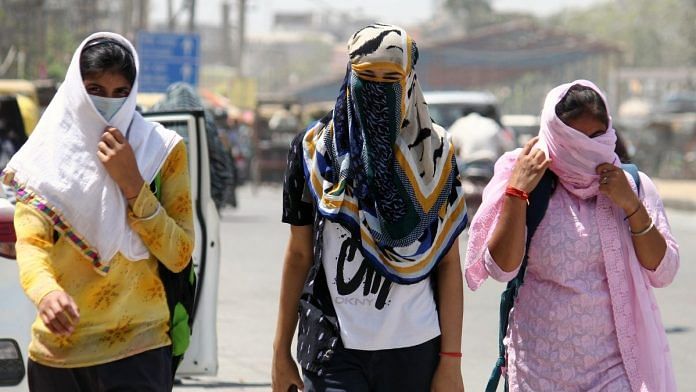New Delhi: The India Meteorological Department (IMD) has issued a heatwave alert for eastern Indian regions, including Odisha and West Bengal, predicting temperatures above 43 degrees Celsius in over 15 districts for the next five days. It has also predicted rainfall in several northeastern states.
Due to a cyclonic circulation over Assam, parts of Odisha, Jharkhand, Bihar, and West Bengal are also expected to see moderate rainfall and lightning, thunderstorms, and gusty winds until 23 April, the IMD said.
The heatwave — attributed to a persistent dry trough across the area — has been ongoing for a week, with minimal relief expected from the thunderstorm and lightning advisories in Odisha, according to IMD spokesperson Dr Naveen Kumar.
Odisha, West Bengal, Jharkhand, and Bihar have been experiencing elevated temperatures since last week, with Odisha under heatwave conditions since 15 April and West Bengal since 17 April, according to IMD’s press release issued Sunday. Nighttime temperatures in these states are also higher than usual and are expected to remain so throughout the week, it added.
According to Kumar, the expected rainfall in the regions will not bring any relief from the heatwave conditions. “Maybe the temperature would reduce marginally in Odisha, but overall heatwave chances are very high for the next five days in the region,” Kumar told ThePrint.
The IMD has also forecast ‘hot and humid weather’ for parts of West Bengal, Andhra Pradesh, Tamil Nadu, and Kerala. While a heatwave is declared when the temperature is 4-6 degrees Celsius above normal, hot and humid weather is declared when it is 3 degrees Celsius above normal, and humidity is also above normal patterns.
While the current heatwave predictions are for eastern India and some isolated pockets of Karnataka, there is no expected major change in temperatures expected over the rest of the country.
“This is the same thing that happened last year as well, which is why the IMD had predicted an increase in the frequency of heatwaves in the summer of 2024. Right now, northwest India does not have heatwave conditions, but the seasonal forecast for the year has predicted high temperatures there too,” said Kumar.
Also Read: Election fever & extreme heat alert—state govts yet to learn from Kharghar deaths
Why heatwave conditions?
Above-normal temperatures and heatwave warnings were flagged earlier this year in the IMD’s seasonal summer forecast report. The IMD’s 1 April forecast said that there will be above-normal heatwave days across most of the country, including east India, north India, and peninsular India, especially in April.
The press release added that April, May, and June will all see above-normal maximum and minimum temperatures, with only a few pockets having normal temperature ranges.
According to the press release, El Nino conditions have been weakening since the beginning of 2024, and are currently moderate.
In March, the World Meteorological Organisation, too, said that a weakening El Nino and the onset of La Nina in later summer this year would lead to high sea-surface temperatures, which would then cause above-normal land temperatures between March and May in almost all places around the world.
Heatwaves in India typically arise from clear skies and reduced cloud cover in summer. “Heatwaves are most commonly caused by anti-cyclonic circulation over a particular area, which causes hot air and lack of moisture that then leads to the heatwave,” said Kumar. “But the current heatwave over eastern India isn’t due to that.”
The IMD spokesperson explained that the current heatwave over eastern India is due to a dry trough over the region. A trough is a low-pressure zone that develops in the atmosphere, and dry troughs are usually associated with heatwaves in eastern and peninsular India.
Meanwhile, the ‘hot and humid weather’ category is defined by high temperatures that induce heat stress without reaching heatwave thresholds. In areas with high humidity, such as coastal regions, the combination of humidity and warmth can lead to widespread heat stress even if temperatures aren’t exceedingly high.
The hot and humid category coincides with ‘wet bulb temperature’, which is the temperature recorded by a thermometer covered with a wet cloth. The heat evaporates the water from the cloth, which then cools the thermometer — this is representative of how the human body cools itself with sweat.
Wet bulb temperature is used globally to determine the temperature at which the body experiences heat stress, typically falling below the official heatwave temperature range.
Like the ‘hot and humid category’ of the IMD, wet bulb temperature takes into account relative humidity for an accurate portrayal of how much heat humans can actually handle. The current threshold for maximum wet bulb temperature that the human body can handle is 35 degrees Celsius, although some studies have said it could be lower.
According to Kumar, the IMD currently does not measure wet bulb temperatures, but it has started this new category of ‘hot and humid weather’ in the last two years.
(Edited by Richa Mishra)
Also Read: India saw 329 heatwave days in 2 yrs, media coverage lukewarm — 2 reports highlight dual challenge



